This article was first presented on March 11, 1994 as a paper for the HMGS Military History Forum during the Cold Wars 94 convention. It is printed here with the kind permission of the author and HMGS.
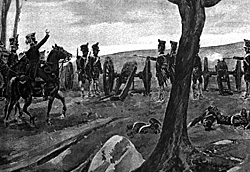 Most historians agree that French Napoleonic artillery was generally superior
to that of its enemies because of the extensive use of massed cannon (also called
"guns"). This article proposes that one of the significant, though often overlooked,
reasons for this situation is that French Revolutionary society was more amenable to
the rise of the very artillery officers who could employ cannon in such a manner.
Autocratic Europe, conversely, still regarded artillery officers as second class soldiers ("mechanicks") and rarely promoted them to the ranks where their influence could be felt. Orders of battle generally tend to confimn these divergent points of view.
Most historians agree that French Napoleonic artillery was generally superior
to that of its enemies because of the extensive use of massed cannon (also called
"guns"). This article proposes that one of the significant, though often overlooked,
reasons for this situation is that French Revolutionary society was more amenable to
the rise of the very artillery officers who could employ cannon in such a manner.
Autocratic Europe, conversely, still regarded artillery officers as second class soldiers ("mechanicks") and rarely promoted them to the ranks where their influence could be felt. Orders of battle generally tend to confimn these divergent points of view.
The general's crisp green uniform disguised an expression of abject horror. The time was 1830 hours, May 2, 1813, and Russian Generalmajor von Berg surveyed the battlefield of Lutzen near the tiny, burning village of Rahna. There lay the remnants of his infantry corps, all but blown to bits by the fire of 80 massed French guns. He recalled watching the devastation, wondering at the time "if Hell weren't half a league off," and then shuddered. The role of artillery on the battlefield had indeed changed. [1]
The French Grand Battery (as massed guns were often called) at Lutzen stands as an example of what many historians believe to be one of the most significant military developments to emerge from the Napoleonic Wars -- the birth of artillery as a decisive battlefield weapon instead of one of support. This simply meant that massed fire could well be the single determinant of victory, exclusive of the contributions of other arms, and it was not hard to figure out why.
A group of massed artillery pieces, carefully deployed to target the enemy under
the watchful eye of an experienced artillery general, could easily obtain a degree of
accuracy and effect unknown to batteries acting individually in a direct support role. Such
a bombardment would usually break its unfortunate target, for it was almost impossible
for any formation of troops to absorb so much punishment so quickly and still stand.
Proof
Proof of this last point can be found in the ammunition expenditure returns of the French army at Lutzen. Marshal Ney's III Corps and its 71 guns fired some 12,150 rounds during their nine hour engagement, or about 19 rounds per gun per hour. The 58 guns of the French Guard Artillery, which were employed only as a Grand Battery element (and then only for a period of two hours), more than doubled this rate of fire (5,813 rounds total). [2]
Interestingly, American Civil War statistics tend to parallel these mathematics. At Gettysburg (July 1-3, 1863), Captain James Hall's six gun Maine artillery battery reported
firing only an average of 15 rounds an hour per gun in its infantry support role. [3]
The massed battery fire that preceded Pickett's charge, however, saw 138 plus guns
expend 15,000 rounds over the course of 90 minutes, or about one round per gun per minute
(four times the rate of Hall's lone battery). [4] Such
figures go a long way in explaining the Napoleonic period's conventional wisdom
which decreed that massed fire "was more powerful than the sum of its parts." [5]
Some historians have explained this by noting that Napoleon himself was an artillery officer, and by also pointing out that a decline in the quality of French infantry forced the use of massed artillery fire to compensate. While there may be some credence in the first
explanation, the second is questionable. Frederick the Great, after all, also saw the
effectiveness of massed guns at both Rossbach (November 5, 1757) and Leuthen (December
5, 1757). [6]
However, he also noticed the qualitative decline of his own infantry. His solution to the
latter was to forgo massed artillery doctrine and send the big guns down to the infantry.
[6] Napoleon likewise did somewhat the same
thing for the same reason when he ordered battalion guns deployed to his infantry in
preparation for his 1812 invasion of Russia. [8]
A Hint
Frederick, however, may indeed have given some hint as to why Napoleonic France became
the nation that turned the big guns into a decisive battlefield weapon through the use of
massed fire. Simply, it may have been that Revolutionary and Napoleonic France was
more socially amenable to such doctrinal changes and the officers who promoted them.
Here one must turn to the crucial subject of people, specifically the artillery gunners and,
more importantly, their officers. Concerning such matters British historian Philip J.
Haythornthwaite summed up Frederick's view by stating:
Such attitudes were understandable in the rigidly structured societies of autocratic
Europe. The very first cannoneers were more likely than not skilled tradesmen rather than
regular soldiers, and this stereotype stuck. The very nature of artillery combat promoted this
impression as the typical gunner needed technical and mathematical expertise much
more than he did the leadership abilities of a mounted knight or dismounted men-at-arms.
Dr Russell F. Weigley of Temple University notes further that, "the technical branches that demanded a mathematical education, that is artillery and engineering, carried disproportionately little weight in command councils because noblemen did not customarily acquire the appropriate education, and consequently the artillery and engineer officers were of inferior social standing." [10]
Weigley also writes that this problem was exacerbated by the fact that the "technical
trade of artillery combat had about it, if anything, even less chivalric romance than
infantry combat." [11] The fact that the great Frederick
himself held such views only seemed to verify them.
All of this manifested itself in a number of ways, but one of most fascinating and
conclusive may be found through an in-depth analysis of several orders of battle from the
penod. A close look indicates that this prejudice against the artillery arm insured that few
artillery officers (normally drawn exclusively from the ranks of the minor nobility) ever
reached high rank, particularly that of general officer.
In Frederick's Prussia, for example, only the commander of the 1st Artillery Regiment
was a general, and then only because he also served as that nation's Inspector General of
Artillery. [12] This was normally not a field command
position, thus shifting battlefield decisions about the employment of the guns to generals who
often had little first hand knowledge of the employment of cannon or their capabilities.
Many times the guns were doomed to deployment by men whose title was General der Infanterie or General der Kavallerie. The other nations of Europe generally followed suit in this regard.
Little Change
For example, at the beginning of the 1809 campaign, the six line corps of the Austrian
army counted only one general of ficer (VI Corps' FeldmarschallLeutnant Freiherr von Rouvroy) as an artillery chief. [13] The other five corps made do with two colonels, one lieutenant colonel and two majors. [14]
The organization of the Prussian army of 1806 does not show any senior artillery officers present at either the army or division level. [15]
nstead, a single battery was permanently attached to support a single brigade, making the lowly Hauptmann (captain) the most knowledgeable cannoneer present. Under such circumstances, one begins to perceive a glimmer as to why the Prussians never employed their guns in mass during the campaign. This, in turn, partially explains why they lost. As the U.S. Army War College's Dr Richard Gabriel noted, "People wondered if the Prussian army of 1806 was still the army of Frederick the Great. It was, and this was the whole problem." [16]
Several orders of battle from the Napoleonic era, of course, do show instances
where general officers were present to control the guns, but closer analysis indicates they
were often not trained artillery soldiers. Witness Feldmarschall Prinz Blucher's Chief of
Artillery in 1815. This was Prussia's General der Infanterie Prinz August, who by his official
title of rank and previous command experience was an infantry officer. [17]
Likewise, Czar Alexander's Russian army at Austerlitz (December 2, 1805) boasted
the services of Generalmajor Meller-Zakolmelski as the Chief of Artillery. [18] This same name reappears on later battle rosters time and
time again. but always as a cavalry or infantry commander, indicating a
service background other than as a trained gunner. The previously mentioned Austrian
army of 1809 fared little better. Here the army's head gunner was Erherzog Maximilian
d'Este, an of ficer who may not have had a great deal of experience in artillery affairs, but
who was, after all, related to the ruling house of Hapsburg. [19]
That the Allied powers were able to get away with this sort of arrangement reflects reflects on the general perception that artillery was a supporting arm to the infantry or cavalry.
This being the case, there was little need for an artillery commander to concern
himself with galloping to the front with fifty guns, deploying them and personally
controlling them as they blasted away at the enemy. Instead, an officer like
MellerZakolmelski needed only to insure that the ammunition was distributed, dead
and wounded horses replaced, and so on. Administrative functions, particularly in
the area of logistics, normally comprised most of such an officer's primary duties
while in the field.
Learned Lessons
Of course, some of the Allied officers did learn well the hard lessons of the early Napoleonic battlefield. Here again one must look to Russia, whose love of large guns, and
lots of them, can be traced as far back as the reign of Peter the Great. For example, the
skillful Generalmajor Aleksandr I. Kutaisov consistently employed his guns well during the
early years of the Napoleonic era. His reputation was such, in fact, that he was given
command of the 1st West Army's Artillery Reserve at the Battle of Borodino (September 7, 1812). Unfortunately, Kutaisov was killed while leading an infantry charge, and thus his guns were never employed. Nevertheless, Kutaisov's previous performance and strength of personality, when coupled with French successes, seems to have made a lasting difference. It seems no
coincidence that the Russian army that invaded France in 1815 boasted a major general as the
artillery commander for most of their deployed infantry corps. [20]
Regardless of exceptions like Kutaisov and the Russian military in general, however,
the evidence clearly points to the fact that Allied artillery officers simply did not enjoy the
importance that their battlefield role deserved. The scarcity of artillery generals in orders of battle merely highlights this fact, even in 1813, when the Prussians (who should have learned
something by then) assigned no one of higher rank than Oberstleutnant (lieutenant
colonel) to run the artillery of their four corps. [21]
The overall result, for the Allied powers at least, was that artillery would remain relegated to a supporting role of the more important cavalry and infantry branches. There were
notable exceptions, but they remained just that -- exceptions only.
Surprisingly, such nonsense continued for some time past the Napoleonic period when most
commanders should have realized their folly. In the American Civil War, for example, one finds
Confederate artillery coming off much better than expected as compared to their better equipped
Federal counterparts, particularly so in the East in Robert E. Lee's Army of Northern Virginia.
According to historians at the U.S. Army War College, one reason for Confederate artillery
parity despite inferior guns and supplies was that the Confederates formed their artillery into multi-battery battalions with a colonel or lieutenant colonel in charge. On the Union side, although this was also eventually done, one finds that the chief artillery of ficer for a command was only a captain or lieutenant. When competing for the corps commander's attention or limited resources, the Confederate artillery major or colonel had a much greater chance of having his opinion considered than did the Union captain or lieutenant. The similarity between the American Civil War artillery command situation and the artillery practice of Napoleon's enemies remains striking. [22]
French Social Prejudices
But if the social prejudices of autocratic Europe can at least partially explain the reasons behind the lack of massed artillery employment among the Allied powers, what of France? Here many factors, most not found elsewhere on the continent, meshed together to give the typical artillery officer a much greater voice in the deployment of his cannon than would normally be expected.
While most of these factors appeared as a result of the dynamic societal upheavals brought on by the French Revolution, one must also admit that a general atmosphere of change
had already been established many years prior. France's poor military showing during the Seven
Years' War brought forth a trio of reform minded Ministers of War, all of whom were
willing to try nearly anything to increase the effectiveness of the French military.[23]
Thus by 1778, one already finds du Theil's famous De l'Usage de l 'Artillerie
Nouvelle dans la Guerre de Campagne advocating the use of massed fires to break the
enemy. [24]
It was against this backdrop that the Revolution burst upon the European stage,
changing societies and the armies that served them. In terms of the French military, the
Revolution naturally caused a mass exodus of the nobility (in other words, the army's officer
corps). However, this flight was less pronounced in the artillery than in the infantry
or cavalry for two reasons. The first was that since the artillery officer was held in such low
esteem in the ancien regime, there was less reason for him to desert a society that theoretically would treat him as more of an equal.
The second reason found its genesis in the fact that because both the artillery offcer
and his gunner needed training in technical affairs, interpersonal relationships between
officer and enlisted tended to be more cordial than in other parts of the army. Such a
situation fit well into a society that, theoretically at least, championed the cause
of human social equality. Indeed, Professor Gunther E. Rothenberg of Purdue University
has stated that in France, "officers and men shared classes and instructions and on the
eve of the French Revolution the artillery was the most democratic branch of the
armies." [25]
Here caution must be used, however, as it is easy to overestimate the impact that these factors had on the armies of Revolutionary France. Dr John A. Lynn of the University of Chicago
Urbana in particular has offered studies that indicate the ariillery was not overly effective in retaining its royalist officers. [26]
Nevertheless, these same figures show that retention was significantly higher, by a factor of fifteen percentage points, when compared to the cavalry in April 1794. [27]
Overblown or not, the decision of many royalist artillery personnel to stick with their
guns is at least one reason why the artillery arm emerged from the French Revolutionary
Wars as the most competent branch of Paris' military. Undoubtedly this enhanced reputation
helped the average artillery lieutenant colonel compete with his infantry or cavalry
counterpart with a greater degree of equality tban in the past.
Nature of Society
Nevertheless, one must never forget that the foundation of this new reputation remained snugly nestled within the very nature of French Revolutionary society. This was a society that
championed "liberty, equality and brotherhood." This radical departure from what was the
accepted societal norm insured the greater retention of royalist artillery officers, regardless
of where the numbers fell, and this helped to give the cannoneers their excellent standing at
war's end. Such societal perceptions (along with the fact that the noble elite had fled the
country) guaranteed that artillery officers could go far in their careers, even as far as their infantry or cavalry contemporaries. And when the artillery officer spoke on affairs of war, no one hesitated to listen. Napoleon's background as a gunner obviously lent emphasis to an already
favorable situation.
A close study of the French side of Napoleonic orders of battle greatly confirms
these perceptions. Remembering the Allied situation above, one finds the French army at
Wagram (July 6, 1809) weighing in with a general offcer commanding the artillery in each
of their seven infantry corps (four major generals and three brigadier generals, with the
Imperial Guard counting as one corps). [28]
Artillery generals were also to be found at Napoleon's army level headquarters, often
standing side by side with one of the Emperor's Aides de Camp. At least one of the
latter was a qualified artillery general officer who, when time was critical, could be directed
by Napoleon to personally take charge of subordinate units' guns and command them in
action. Such a situation actually happened at the battle of Wagram, where General de
Division Count Law de Lauriston, acting in the name of the Emperor, stripped the guns
away from several formations and deployed them for combat. [31]
Napoleon's Influence
The incident does call to mind the overwhelming influence that Napoleon, as a
school trained gunner, could have had in forcing such issues. As noted before, some historians
have pointed to this fact as a major reason the French employed massed guns so often.
Battles like Friedland (June 14, 1807), however, provide ample evidence to the contrary. Here the French I Corps artillery commander, General de Division Alexandre Senarmont, collected the corps' entire complement of 36 guns and mounted a daring artillery "charge" against the Russians.[32]
He did so with the specific permission of the corps commander, General (later Marshal)
Victor, who did not hesitate to accept the advice of his senior gunner. [33] As the Emperor was not on the scene, other influences
were probably at play.
We can probably guess what the answer Prussian General Kalkreuth (at Auerstaedt in
1806) would have given to one of his young artillery captains, had he asked permission to
make such an unorthodox maneuver. The relationship between artillery rank and status
within an army based upon the values of differing societies surely becomes evident.
Almost without exception, French artillery commanders were professional artillerymen and
as such were not qualified to lead infantry or cavalry formations. One such example is
General de Division Baron Jean-Jacques Desvaux de St. Maurice, the commander of the Imperial Guard Artillery during 1815. This gentleman was educated at the artillery school of Chalons, saw extensive service with horse artillery units during the Revolutionary Wars and took command of the 6th Horse Artillery Regiment on October 29, 1803. [34] He was later given command of the Guard Horse Artillery, finally receiving his
promotion to General de Division on January 20, 1814. [35]
Artillery generals such as St. Maurice were good at gunnery, however, and regardless
of the reasons why, the French artillery arm served the nation well because of it. While
many will say that a French arti11ery officer's new found social status cannot be confirmed as
the single most important reason for French prowess, battlefield performance and a host of
qualified artillery generals indicate that it cannot be discounted.
To be sure, other factors (such as terrain, tactical situation and command personality)
undoubtedly influenced the manner in which both sides employed their guns throughout the
period. Yet the concept of social equality seems to explain much when one notes French
dominance in massed artillery employment and the abundance of qualified artillery general
officers on the battlefield. Military philosopher Carl von Clausewitz noted the role of society in war, and it would seem that the French predilection to use massed artillery fire
indirectly supports that assumption. At the least, it points to a piece of the Napoleonic saga that deserves much more study than it has received before.
And as for Generalmajor von Berg, he would have been little surprised at the comments made by his opponents after the crushing artillery storm of Lutzen. The commander of the guns, General Antoine Drouet, noted that "the deadly blasts of our guns cut down the enemy by the thousands." [36]
One of the Emperor's Aides de Camp, General Flahaut de la Billarderie, agreed, later recalling, "We passed over the wreckage of entire regiments which had been cut down by our guns. At times, the enemy dead and wounded were so thick that our mens' feet did not touch the ground." [37]
The role of artillery on the battlefield had changed. How ironic to think that the nature of
the society the Allied coalitions sought to destroy provided at least a partial explanation as
to why.
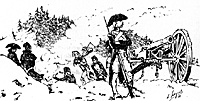 This was exacerbated by a Grand Battery's accelerated rate of fire, probably the single most important element in its success. While individual batteries in direct support of an infantry brigade tended to conserve their scarce quantities of ammunition, extra rounds were normally supplied to massed gun formations. At that point, it became a simple matter of having
the gunners aim, fire and reload as quickly as possible. Massed battery targets, such as an
infantry division in defensive positions, rarely moved, while the guns themselves were
normally deployed in such a way as to preclude outside distractions (the proverbial unseen
enemy lancer regiment). Thus, rate of fire increased as did its effect upon the enemy.
This was exacerbated by a Grand Battery's accelerated rate of fire, probably the single most important element in its success. While individual batteries in direct support of an infantry brigade tended to conserve their scarce quantities of ammunition, extra rounds were normally supplied to massed gun formations. At that point, it became a simple matter of having
the gunners aim, fire and reload as quickly as possible. Massed battery targets, such as an
infantry division in defensive positions, rarely moved, while the guns themselves were
normally deployed in such a way as to preclude outside distractions (the proverbial unseen
enemy lancer regiment). Thus, rate of fire increased as did its effect upon the enemy.
 But while such physical details explain why massed fire was effective, they only
partially explain why such practice became prominent in the Napoleonic Wars, particularly
in the French Army. One wonders, forexample, why the Allied powers did not more frequently
use such Grand Batteries if their utility had been conclusively proven. The Russian Army
certainly had the necessary ordnance on hand.
But while such physical details explain why massed fire was effective, they only
partially explain why such practice became prominent in the Napoleonic Wars, particularly
in the French Army. One wonders, forexample, why the Allied powers did not more frequently
use such Grand Batteries if their utility had been conclusively proven. The Russian Army
certainly had the necessary ordnance on hand.
"Despite making a number of important innovations, Frederick was not renowned as a great artillery enthusiast, and treated his gunners as second-rate soldiers hardly fit for the 'gentlemen' who officered the otherbranches of the Prussian army. In fairness, for all Frederick's insistence upon maintaining the aristocratic element of his officer corps, this was not a view unique to Prussia. Artillerymen were equally looked down upon in other armies, especially the French, as being -- to use a contemporary British term -- 'mechanicks' whose technical knowledge reduced them to the level of tradesmen [9]
."
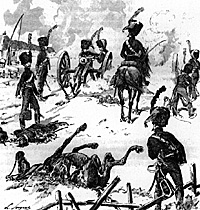 The coming of the French Revolution and Bonaparte saw little change among the Allies.
Not only through the early days of the French Empire, but throughout the entire Napoleonic
period one finds that majors and lieutenant colonels represent the majority of senior Allied
present the majority of senior Allied artillery off cers present at any one battle.
The coming of the French Revolution and Bonaparte saw little change among the Allies.
Not only through the early days of the French Empire, but throughout the entire Napoleonic
period one finds that majors and lieutenant colonels represent the majority of senior Allied
present the majority of senior Allied artillery off cers present at any one battle.
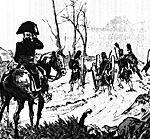 Such restrictions of rank exposed the basic predicament of any qualified artillery officer who was on hand. Assuming he recognized the value of massed fire, he would then have to convince his commander of the necessity of stripping guns away from the infantry or cavalry units they supported. Doing this meant that he would have to compete for such resources with the major or lieutenant general who commanded the unit about to lose the guns. The old military adage that "rank has its privileges (RHIP)" virtually assured which officer's advice would carry the most weight.
Such restrictions of rank exposed the basic predicament of any qualified artillery officer who was on hand. Assuming he recognized the value of massed fire, he would then have to convince his commander of the necessity of stripping guns away from the infantry or cavalry units they supported. Doing this meant that he would have to compete for such resources with the major or lieutenant general who commanded the unit about to lose the guns. The old military adage that "rank has its privileges (RHIP)" virtually assured which officer's advice would carry the most weight. 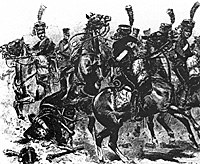 Given such a perspective, it is easy to understand why the typical artillery officer
found it much easier to slip into the military of a Revolutionary France than did his
cavalry colleague.
Given such a perspective, it is easy to understand why the typical artillery officer
found it much easier to slip into the military of a Revolutionary France than did his
cavalry colleague.
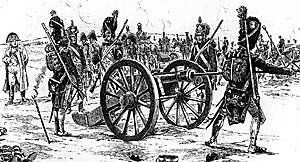 One finds nearly an identical situation when the French army faced off against the
Prussians across the fertile hills of Jena and Auerstaedt. [29] The situation was not as favorable in terms of available artillery officers during the
1813-1814 campaign, but only because of the enormous casualties taken by the French army
during the retreat from Moscow. By 1815, all had been corrected and the French Armee
du Nord that rumbled into Belgium could count on the services of an artillery general
with each infantry corps. [30]
One finds nearly an identical situation when the French army faced off against the
Prussians across the fertile hills of Jena and Auerstaedt. [29] The situation was not as favorable in terms of available artillery officers during the
1813-1814 campaign, but only because of the enormous casualties taken by the French army
during the retreat from Moscow. By 1815, all had been corrected and the French Armee
du Nord that rumbled into Belgium could count on the services of an artillery general
with each infantry corps. [30]
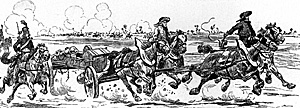 A study of these orders of battle also points to another significant difference between
the armies of France and those of the Allied powers. This is simply the fact that French
artillery commanders generally do not show up elsewhere as either infantry or cavalry
commanders. A look at a few biographies explain why.
A study of these orders of battle also points to another significant difference between
the armies of France and those of the Allied powers. This is simply the fact that French
artillery commanders generally do not show up elsewhere as either infantry or cavalry
commanders. A look at a few biographies explain why.
Footnotes
[1] Nafziger, George F. Lutzen and Bautzen, Emperor's Press (EP), Chicago, 1993, pp. 168-275, Napoleon's GrandeArmee of
l813, EP, Chicago, 1990, pp. 81-82. Nafziger indicates 198 guns in the French
Grand Battery, counting those of the III Corps. Bowden disputes this.
[2] Nafziger, Lutzen and Bautzen, pp.175-176. For a detailed look at exactly how guns were deployed, see Manoeuvres des batteries de
campagne pour l'artillerie de la Garde Imperiale, Paris 1812, available at the U.S. Army Military Institute, Carlisle Barracks, Pennsylvania.
[3] Dr. Jay Luvaas and Col. Harold Nelson, The U.S. Army War College Guide to the Battle of Gettysburg, New York, 1986, pp. 14-15. Likewise,
Jennings Cropper Wise, on page 274 of his book The Long Arm of Lee (Lincoln, Nebraska, 1991), notes that Austrian batteries at Leipzig (October 16-19, 1813) only fired 66 rounds a day.
[4] Albert A.Nofi, The Gettysburg Campain, June and July 1863, New York, 1986, p. 84, pp. 148-149; Edwin B. Coddington, The Gettysburg Campaign, A Study in Command, New York, 1986, pp. 493-500. The duration of this bombardment is in dispute, estimates ranging from 30 minutes to two hours. Regardless, the increase in rate of fire was substantial.
[5] Haythornthwaite, Philip J. The Napoleonic Source Book, New York, 1990, p.107.
[6] Haythornthwaite, Philip J. Frederick the Great's Army III, Specialist Troops, London, 1992, p. 7.
[7] Nafziger, George F. Napoleon's Invasion of Russia, Novato, 1988, pp. 35-36.
[9] Haythornthwaite, Philip J. Frederick the Great's Army III, Specialist Troops, London, 1992, p. 1.
[10] Russell, Dr. F. Weigley, The Age of Battles, Bloomington, IN, pp. 10-12.
[11] Ibid, p. 38.
[12] Haythornthwaite, Philip J. Frederick the Great's Army III, Specialist Troops, London, 1992, p. 1-2. Britain is a good example of this type of
thinking for the Napoleonic period. Her artillery was part of the Board of Ordnance, a body commanded by a lieutenant general. Directly commanding the Royal Regiment of Artillery was his
deputy, a major general. Both were administrative positions, not field commands. Compounding this problem was the fact that the British normally had too few guns to begin with, and often
fought in terrain (i.e., the mountains of Spain) not suited for massed artillery employment. Thus at Waterloo, Wellington's top gunner was Colonel Sir George Adam Wood. Napoleon employed
a major general. See Nafziger, George F. and Park, S.J. The British Military, 1803-1815: Its System and Organization, RAFM, Cambridge, Canada, 1983, p. 39 and Bowden, Scott,
Armies at Waterloo, Arlington, Texas, 1983, p. 229.
[13] Bowden, Scott and Tarbox, Charles, The Armies on the Danube: 1809, Chicago, 1989, pp. 76-82.
[14] Ibid, The artillery chiefs were: I Korps - Oberst von Stwrnik, II Korps - Major von Kfeller, III Korps - Oberst von Smola, IV Korps, - Oberleutnant Graf Kunigl, V Korps - Major Adam Pfefferkorn, 1st Reservekorps - Major von Nesslinger.
[15] Chandler, David G. Jena 1806: Napoleon Conquers Prussia, London, 1993, pp. 40-43; Oberst Oscar von Lettow-Vorbeck, Der Krieg wn 1806 und
1807, Vol. I, Berlin, 1899, pp. 431-437 with pull-out charts.
[16] Recorder in the notes of the author from a lecture given in a U.S. Army War College seminar on war in the ancient world.
[17] Bowden, Scott, Armies at Waterloo, p. 159; Major von Frederick's work Geschichte der Befreiangskrieg 1813-1815 (Berlin, 1906) confirms Prinz August's status as an infantry commander in several locations. For example, the first volume covering the 1814 campaign (Appendix V, p. 20) shows the good general commanding the 12th Infantry Brigade in General-Leutnant von Kleist's II Korps.
[18] Nafziger, George F. Order of Battle Collection, Austerlitz OB for the Allied Armies, File 805LCJ; General Barron Levin Bennigsen, Memoires du General Bennigsen, Paris, 1908, pp. 287-292; Nafziger, Napoleon's Invasion of Russia, 1812, pp. 262-263. There was a distinguished Russian Inspector General of artillery named Meller Zakolmelski, but he had passed away in 1790. Perhaps it was his glowing reputation that allowed another member of his family to command the guns at
Austerlitz. The name reappears twice in 1807, with a lieutenant general commanding the Russian X Infantry Division and a major general commanding a brigade of dragoons (serving as the regimental proprietor of the Kargopol Dragoons to boot). The major general's name reappears again in 1812, this time with the Russian Guard Light Cavalry.
[19] Bowden and Tarbox, p. 76.
[20] Der Krieg des Verbundeten Europa gegen Frankreich
im Jahr 1815, Berlin, 1818, pp. 56 61 of the Appendices. The officers were: III
Korps - Generalmajor Kastanzky, IV Korps - General Suchasanett, V Korps - Generalmajor Nikitin, VI Korps - Generalmajor Wassilitzky, VII Korps - Oberst Tscherenissonov and Reservekorps Oberst Ruus.
[21] von Plotho, Carl, Der Krieg in Deutschland und Frankreich in den Jahren 1813 und 1814, Vol. II, Berlin, 1817, Appendix, pp. 9-23. The III
Korps artillery commander, Oberstleutnant von Holtzendorf, was promoted to the rank of major general by 1814. The artillery commanders of the other three corps were Oberstleutnant von Schmidt of I Korps, Oberstleutnant von Braun of II Korps and Oberstleutnant von Strampf of IV Korps.
[22] This was a repeated theme at several U.S. Army War College staff rides which the author attended on the Battle of Antietam.
[23] Hwe Strachen European Armies and the Conduct of War, London, 1983, p.38. The ministers were Choiseul (1761-1770). St. Germain (1775-1777) and Puysegur (1788-1789).
[24] Ibid,, p. 34.
[25] Rothenberg, Gunther E., The Art of Warfare in the Age of Napoleon, Bloomington, Indiana, p. 28.
[26] Lynn, Dr. John A., Bayonets of the Republic: Motivation and Tactics in the Army of Military France, Chicago, 1984, pp. 207-208.
[27] Ibid. p. 208.
[28] Bowden and Tarbox, pp.184 195. The officers were: Imperial Guard - General de Division Count Lauriston, II Corps General de Division Bondurand,'
III Corps - General de Division Hanicque, IV Corps - General de brigade Pernetti, Corps Macdonald - General de Division Count Sorbier, IX Corps - General de brigade Mossel and XI Corps - General de brigade Tiblet. Only the VII (Bavarian) Corps did not fit the pattern, but only one
Division of this formation was present. The IX Corps was Saxon.
[29] Chandler, pp. 34-37. For example, one finds in I Corps General de Division Jean-Baptiste Eble and in V Corps General de brigade Louis Foucher
de Careil.
[30] Bowden, Armies at Waterloo, pp. 72-109 and pp. 278-289. The offlcers were General de Division Desvaux de St. Maurice for the Imperial
Guard, General de brigade Desales for I Corps, General de brigade Doguereau for
III Corps, General de brigade Baltus de Pouilly for IV Corps and General de
Division Baron Noury for VI Corps.
[31] Bowden and Tarbox, pp.173-175. The guns included pieces drawn from the Imperial Guard, the Army of Italy and Freiherr Karl von Wrede's Bavarian
Division.
[32] General de Division Alexandre Senarmont, "After Action Report to Prince Bernadotte on the Battle of Friedland, 1807," entire document. See
also Maurice Girod de l'Ain's Grand Artilleurs: Drouot, Senarmont, Eble, Paris 1895.
[33] Ibid.
[34] Bowden Armies at Waterloo, p. 73. The army's artillery commander, Count Charles Etienne Francois Ruty, enjoyed a similar background.
[35]Ibid.
[36] Bowden Napoleon's Grande Armee of 1813, p. 81.
[37]Ibid, p. 82.
Back to Empire, Eagles, & Lions Table of Contents Vol. 2 No. 9
Back to EEL List of Issues
Back to MagWeb Master Magazine List
© Copyright 1994 by Emperor's Headquarters
This article appears in MagWeb (Magazine Web) on the Internet World Wide Web.
Other military history articles and gaming articles are available at http://www.magweb.com
